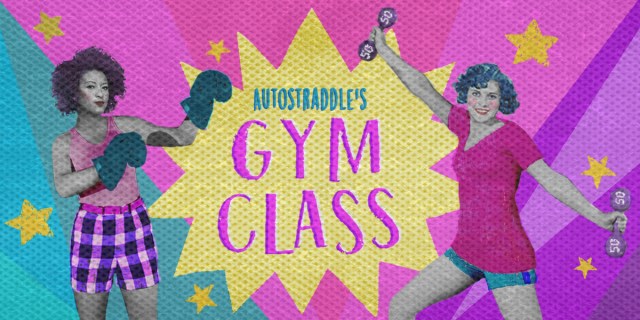
Greetings, Gym Class! Blend up a protein shake and get ready to set a new personal best. It’s just you and the barbell, baby. Today’s article is all about powerlifting.
Introduction to Powerlifting
Powerlifting consists of three major lifts: squat, deadlift, and bench press. Should you choose to compete, you will be testing your strength in these three lifts in competition with other people in your weight class. Do you have to compete to be a powerlifter? Hell no! All that matters is putting in the time and sweat to set your personal record (PR) on a lift, and then putting in more time and sweat and crushing your old record. Rinse and repeat, set new PRs. Awesome.
I fell in love with powerlifting four years ago. My friend Kelly had started lifting and raved about it to me: how challenging it was, how good it was to feel so strong. I’d used a barbell back in college, when I did some basic lifts for rowing-team training. But the free-weights area of my gym — with its huge plates, huge dudes, and chorus of grunting — had always felt intimidating.
Powerlifting made me feel at home among the free weights. The sport gave me a clear training plan to follow: what lifts to do, how many of each, even what order to do them in. Studying up on the lifts gave me confidence that I was using the equipment properly. And getting in the squat rack, day after day, helped me remember I had just as much right to be there as the big guys around me. Four years in, I’m stronger, healthier, and still chasing new PRs. I hope to pass the lifting love on to you!

Things You’ll Need
– Hard-soled shoes. Converse are great. Avoid running shoes, or others with a squishy sole. A thick-soled shoe puts a cushion between your feet and the ground, taking away some of the power of your lift.
– A small notebook. Before going to the gym, figure out which lifts you’re doing that day, how many reps to do, and the weights for each rep, and write it out in your notebook. Your workout will be as easy as following the written plan.
– Comfortable workout clothes. I prefer a T-shirt and leggings to lift.
– Chalk. Lifting chalk keeps your grip strong (especially for deadlifts) when your palms are sweaty.
Basic Technique
In this section I’ll introduce you to The Big Three: the squat, deadlift, and bench press. There are tons of resources online that get into the mechanics of these lifts. So I’ll keep things brief here, and encourage you to study up as much as you need before trying the lifts for yourself.

Squat
Set the barbell on your upper back, bringing your hands as close to your shoulders as possible to trap the bar in place. Step clear of the rack and stand with your feet a little wider than your hips, toes pointed slightly out. Take a deep breath and tighten your core, then drop down until your hip crease is below the top of your knee. Still holding your breath and keeping your spine straight, return to standing. (Note: Squat racks either have fixed or adjustable weight rests — where the barbell sits before you unrack it — and safety rails. Take time during your first session to familiarize yourself with the rack. If it’s adjustable, figure out which settings work for you and note them so you can set up efficiently for your next workout.)
Deadlift
Grip the bar that’s resting on the floor with a flat back and your arms perpendicular to the floor. From this stable starting position, pick up the barbell and stand to an upright position with knees locked and shoulders back. (The power here is coming primarily from your legs and glutes, not your back.) Return the bar to the floor.
Bench Press
Unrack the barbell and hold it at arm’s length. Bring the bar down so it touches your chest, keeping your elbows out at a 45-degree angle from your sides. If you wear a sports bra, aim to have the bar touch just above the band of your bra. Push the bar back up. (Safety note: When benching, make sure you wrap your thumbs around the bar. This will ensure the bar can’t slip out of your grip and drop onto your face. Ouch.)

Supplemental Lifts
In addition to the big three lifts, take some time getting to know the following exercises. Adding them into your routine will help you get a comprehensive, full-body workout: overhead press; barbell and dumbbell rows; pull-ups and lat pull-downs; core exercises such as planks, Russian ab twists (RATs), Turkish get-ups, bird-dogs, and hanging leg-raises.
Training & Sample Workouts
Each week, I do three powerlifting workouts and two to three cardio workouts. Cardio workouts don’t have to be in the gym! You’re aiming for 30-45 minutes of an elevated heart rate. You can do that by walking or jogging on a treadmill, but you can also take your dogs for a walk, go for an urban hike with friends, swim, play basketball, go dancing… Anything to get you moving around and feeling good.
My powerlifting workouts are adapted from the Starting Strength method (see the Tips & Resources section for more on this): Workout A is squat, bench, row; Workout B is squat, deadlift, overhead press. Week 1 would be A – B – A, Week 2 would be B – A – B, and so on, switching back and forth. Take a rest day between each workout. This is a typical week:
Monday: Squat, bench, row, band-assisted pull-ups, core work
Tuesday: Rest day, 30 minutes walking
Wednesday: Squat, deadlift, overhead press, core work
Thursday: Rest day, 1 hour hiking
Friday: Squat, bench, row, band-assisted pull-ups, core work
Saturday: Rest day, 2 hours dancing
Sunday: Rest day
Here’s a beginner-level workout, again following the Starting Strength programming. It includes warm-up sets, mid-weight sets to get your body in gear, and then work-sets, where you’re really pushing. 5×45 translates to 5 reps at 45 pounds. This is an easy place to start because the unloaded barbell weighs 45 pounds. So you just use the bar for these sets! Work-sets are in bold:
Squat: 5×45, 5×45, 5×45, 3×55, 2×65, 5×85, 5×85, 5×85
Deadlift: 5×95, 5×95, 5×95, 3×105, 2×115, 5×135
Overhead Press: 5×45, 5×45, 5×45, 3×50, 2×55, 5×60, 5×60, 5×60
When you first begin, practice every lift with the unloaded bar. Make sure you feel steady and safe before adding any weight. It may take a few workouts for you to put plates on the bar, and that is absolutely fine. Especially with a lift like the overhead press, where you’re using the relatively small muscles of your shoulders, 45 pounds will feel like a lot. If it’s too much, you can work up to the barbell with dumbbells or smaller fixed-weight bars.
Once you feel ready to start adding weight, follow your selected training plan’s method of progression. Each training plan will have different ways to calculate your work-sets and how to build up to them. As a beginner you can build strength and set new PRs quickly. You’ll also learn a lot about your body — where you are naturally strongest, and where you’ll need to focus extra attention. In my case, I’m tall with long limbs and pretty good flexibility. This helps my deadlifts but is not great for squats. I still struggle with squats and I’ve been lifting for years! A big part of this sport is being stubborn and not giving up on reaching new PRs, even when it’s been a while since you set a new personal best.

Good-to-Know Tips
Before you begin, choose a training program.
You don’t have to stick with the program forever, but choosing a plan and following it will build discipline and consistency. I chose Starting Strength as my initial program. The Starting Strength book breaks down the mechanics of each lift with photos and form tips. It also covers how to plan your workouts and weight progression. Other training programs include Wendler’s 5/3/1, the Texas Method, and StrongLifts 5×5. You could also choose to work with a coach.
Note: Starting Strength (like most guides, unfortunately) is heavily tailored for young cisgender men. There are some pointers for AFAB folks, but they’re not the target audience. Soak up all the knowledge you can while keeping in mind that your center of gravity, your flexibility, and your muscle-building capacity may all be different than what is assumed as “normal” in training manuals.
Train with a lifting partner.
It’s nice to have a workout partner spotting you on tough bench-press sets. Also, at many gyms the free-weights area may not feel welcoming or easy to enter. A workout partner can help you establish your space, figure out stuff like how to adjust the squat rack to your body, and take video of your lifts as you fine-tune your form.
Up your protein intake. Feed your muscle growth with lean protein, good fats, and complex carbs. There are plenty of nutrition guides online if you want to tailor your eating to suit your powerlifting. If you’re having trouble building muscle, you’ll probably need to add calories (with a focus on calories from lean protein) to your diet.
At a new gym, use your free training session wisely. Sign up for this session after you’ve explored the free-weights equipment and tried the lifts a few times. If you use your training session on your very first gym visit (or first time with the barbell), the trainer will likely spend 30 of the 50 minutes walking you around and explaining each piece of equipment. A better idea is to explore the floor yourself, try the lifts, and then meet with a trainer with a list of specific questions. Example: “I’ve been working on squats, but I’m feeling a little shaky at the bottom. Can you go through a few sets with me and help me troubleshoot my form?”
Choose a gym with good lifting equipment.
You’re looking for a squat rack (preferably two or three — and not Smith machines), bumper plates for deadlifts, and a deadlift platform. You should also ask about their chalk policy; some gyms strictly forbid chalk use.

Ease Into It
If you love the sound of powerlifting, but want a middle step before jumping into the squat rack, try doing a few weeks of a bodyweight circuit. This will help you build up strength and improve your mobility in preparation for powerlifting. You can do bodyweight circuits at home. Start with 20 minutes of the circuit three times a week, adding reps or small weights or time to increase intensity as you get stronger. Nerd Fitness has a great beginning bodyweight workout with modifications suited for most strength levels.
Let’s Do This!
Ever since my friend Kelly passed the gift of powerlifting to me, I’ve wanted to share it with others. I hope this article gives you the tools you need to try it. If you have any questions about resources, form, or programming, I’m happy to help. Let’s get stronger together!







